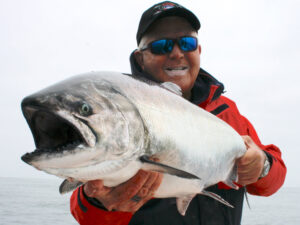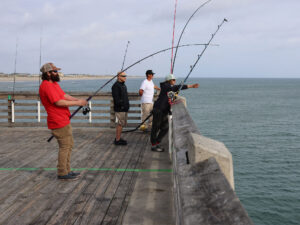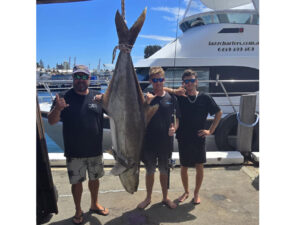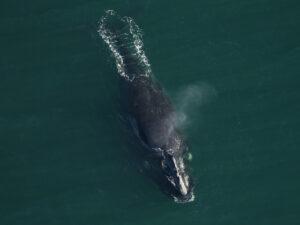eileen sobeck
This past January 27, Eileen Sobeck was named as assistant administrator for NOAA Fisheries. As the chief of that agency, Sobeck will oversee the management and conservation of recreational and commercial fisheries (as well as safeguarding marine mammals and protected species, and coastal fisheries habitat). As a trial attorney and, later, senior manager, Sobeck served in the Environment and Natural Resources Division of the U.S. Department of Justice from 1984 to 2009, and from then until her appointment to NOAA was with the Department of the Interior, most recently as the deputy assistant secretary for Fish and Wildlife and Parks.
SF: What would you describe as your greatest strength and your most significant weakness for your position as head of NOAA Fisheries?
ES: Great question! My greatest strength is that I listen to all sides of an issue. I want to hear from everyone before I make a decision. People may not agree with my decision, but at least they have had a chance to voice their position. That said, I think my biggest challenge is trying to get a handle on all the issues the agency faces. With our multiple mandates – fisheries and protected resources – our regionally-focused structure, and budget constraints, we juggle a lot. I am happy to say though, as I get to know more and more about the agency and our people, I am thrilled to be in this job.
SF: In the few months you’ve been the head of NOAA Fisheries, in what particularly significant ways, if any, have your awareness and attitude changed toward recreational fishing?
ES: We recently wrapped up our 2014 National Recreational Saltwater Fishing Summit where I was able to meet with anglers and business leaders from across the country. This was the latest in a series of visits and meetings I’ve had with the recreational fishing community in my first 90 days. I’ve come away from these meetings with a better appreciation for both the diversity of the fishing communities and their varied interests. We talk a lot here about the social and economic importance of recreational fishing, but getting to meet the people who are so passionate about the sport and its future puts a face to fishing and has made a lasting impression on me. I’m excited to work with such an engaged and engaging group.
SF: You’ve committed NOAA Fisheries to developing a first-ever national saltwater-recreational-fishing policy. While those involved in the sport applaud this, those not involved in recreational fishing might ask you to justify the need for such a commitment. How would you respond?
ES: The reality is that with an organization the size of NOAA, process and policy are important. Having a clear statement about what we believe does two things: first, it institutionalizes our commitment to healthy recreational fisheries and second, it provides guidance when we need to make difficult choices.
SF: To what extent and by what means do you foresee the recreational-fishing community being involved in NOAA’s efforts to develop that national saltwater-recreational-fishing policy?
ES: There will be a number of opportunities for input on this policy for the angling community. I urge everyone who might be interested to stay tuned and engage. For starters, we will host public listening sessions in association with upcoming fishery management council meetings over the summer. We hosted a second national saltwater recreational fishing summit this past April to bring together a diversity of opinions which helped us better understand what anglers would like to see in the policy. We’ll continue this productive conversation with anglers from across the country to craft a policy that reflects the economic and social importance of recreational fishing to the nation and remains true to the agency’s mission to conserve and manage our ocean and coastal resources.
SF: What do you envision as our biggest challenge in marine-fisheries management and conservation over the next 25 years? How will we work together to meet these challenges?
ES: Climate change, pressure on the resource from increasing coastal population growth, and habitat loss are challenges I’ve heard mentioned most frequently by anglers. I would agree these are significant issues that will require coordination among a range of federal and state government agencies, industries, interest groups, and concerned citizens. I find this to be a daunting list that will require changes on many levels to make headway. The more fundamental question to me is: how can we get enough people on the same page to make a difference on these issues … enough to make progress? At the same time, while we are working on these big issues, how do we ensure the next generation has a satisfying recreational fishing experience? I’d like to focus our energy on the practical things we can do today to ensure a bright future while engaging all voices in the discussion.
SF: There are many in Congress who would like to significantly cut discretionary, nondefense budgets. Should that happen, and NOAA Fisheries were left with, say, half its current budget, talking in broad strokes, what would be your highest priorities and where would cuts likely be felt?
ES: Fisheries management isn’t getting any easier or less expensive. We do the best with what Congress provides and this year that’s $916.7 million. The agency has two core missions that we would continue to support through thick and thin – ensure the productivity and sustainability of fisheries and fishing communities and recover and conserve protected resources. But, to your question, should our budgets shrink further, we can expect to see less scientific certainty, fewer fishing opportunities, and less innovation.
SF: Various research has shown that in total, anglers release well over half the fish they catch, but release mortality remains a concern. Fishsmart, the cooperative public/private effort to increase survival, particularly in barotraumatized fish pulled up from deep water, has been an unqualified success in establishing the value of descending devices to greatly reduce release mortality. Yet most fishery management councils have yet to embrace/encourage the use of these devices. What can you do to move this along?
ES: We agree that FishSmart is a great model for how NOAA, industry, and the angling community can work together. We have seen promising results. For example, on the West Coast we’ve worked with the recreational community to test these descending devices, quantified the findings, and seen the Council take steps to begin rewarding anglers for their efforts. At the same time, folks need to understand that the Regional Fishery Management Councils have a tough job with tremendous responsibility to prevent overfishing. They need good science to support their decision-making and our job is to provide them with this information. We will continue to evaluate these new tools in other fisheries using the same rigorous scientific approach we’ve used along the West Coast. We want to do all we can to support anglers’ conservation efforts such as FishSmart.
SF: I trust you’ve read what’s come to be known as the Morris-Deal Commission Report (“A Vision for Managing America’s Saltwater Recreational Fisheries”) released this past February. A great deal of thought and effort by an array of experts and recreational-fishing/boating-community leaders went into the recommendations of this unprecedented document. What stands out in your mind as the single-most memorable and important takeaway from this report?
ES: The Morris-Deal Commission Report stands out to me as a testament to what can be accomplished when a diverse group comes together and says publically what they stand for. Teddy Roosevelt famously said, “It is not the critic who counts…the credit belongs to the man who is actually in the arena.” I think what he meant is that it’s easy to criticize from the sideline. It is a far more courageous thing to step forward with your own ideas and a willingness to work with others to find resolution. The Morris-Deal Commission embodies Roosevelt’s ideal and leaves me optimistic about our ability to develop cooperative and workable solutions with the community.
SF: You’ve already promised that NOAA Fisheries will work cooperatively to address the first of six key recommendations in the Morris-Deal Report, that of establishing a national policy for saltwater-recreational fishing. Beyond that, how do you see NOAA Fisheries working in coming months to effect the second recommendation, that of adopting a revised approach to saltwater-recreational-fisheries management?
ES: We’re already talking with the community about what a revised approach might look like and what may be possible within the context of our Congressional mandates. We think there is flexibility within the current regulations and we may not be using all of it. We will include the Councils and Commissions in these conversations as well, since they have the challenging responsibility of developing the fishery management plans and regulatory measures. With the pending reauthorization of the Magnuson-Stevens Act, Congress will also want to weigh in. I support adapting our management to better meet the needs of today’s fisheries. With many moving parts to consider, we will ensure that conversation includes all those who have a role.
SF: In recent years, NOAA Fisheries’ interest in managing many mixed-used fisheries using catch shares has been of increasing concern to recreational anglers who, in many cases, see this as allocating a public resource to private individuals to the exclusion of the general public who would otherwise enjoy those same resources. This is a very different approach from that used by the Department of the Interior, where you served for some years, and where public resources are in fact managed for public use. Given that experience, do you bring with you to NOAA Fisheries any concerns about the use of catch shares to manage mixed-use fisheries? If not, why not? If so, what changes do you envision in the use of catch shares as a management tool?
ES: Congress added catch shares as one tool in our management toolbox during the last Magnuson-Steven Act reauthorization. I think we have a lot of management challenges and should consider creative solutions. Let me clarify that catch shares do not convey ownership of a public resource. The Regional Fishery Management Councils regularly review and sometimes re-allocate resources on a routine basis. Catch shares proved successful in many commercial fisheries by reigning in derby fisheries and providing stability. It is up to the councils to work closely with the states to determine if and when catch share programs may prove effective or improve the quality of fishing for the recreational fishery.
SF: The third key recommendation of the Morris-Deal Commission would have NOAA Fisheries allocate marine fisheries for the greatest benefit to the nation. Indeed, the issue of how our fish resources are allocated among users has remained a thorn in the side of (some might say a slap in the face to) recreational anglers. That’s because today, most shared fisheries are allocated to commercial and recreational fishermen based on the situation decades earlier when federal fisheries law mandated allocations. But the situation today is far different; yet, mixed-use fisheries generally continue to be allocated without regard for the relative economic importance of recreational versus commercial fisheries. Despite a legal mandate for fishery management councils to consider re-allocating fisheries on a regular basis, most councils continue to avoid this thorny issue completely (often blaming NOAA Fisheries for failing to provide guidance). Do you agree that allocation is a major issue and one that needs to be addressed quickly? If not, why not? If so, how do you plan to have NOAA Fisheries exercise the leadership necessary to fix this?
ES: I think it’s time we take a fresh look at allocations. But deciding who gets what is probably the single most contentious and complex issue faced by fishery managers. Everyone wants a larger slice of the pie and in the end, someone will be unhappy with the size of their slice. It’s understandable then why the Regional Fishery Management Councils are struggling to address these difficult issues, and it is important to continue working on them. There is currently a Council-led working group looking into this issue. There are a number of things we can do, but I want to wait and see what the Council working group comes up with first and build on those suggestions.
SF: I appreciate your candor in publicly acknowledging that you have little personal experience with the sport of fishing, having never been an enthusiast (though I know you’ve snorkeled many waters). But given your current position and the fact that nearly 11 million of your constituents are anglers, do you think it would be useful to get out on our coastal waters and experience the sport, and see how anglers catch — and also release — fish? If not, why not? If so, let’s go! If you’re willing to join Sport Fishing editors one morning on the water, we’ll make that happen.
ES: Thanks for the invite to go fishing, sounds like great fun. As you said, I’m an outdoor enthusiast and a big proponent of outdoor recreation in all its forms. Having fun, whether you are fishing, hunting, or hiking, creates a strong bond between the individual and the resource. Anyone who goes boating, snorkeling, or fishing understands this. Conservation is born from an active engagement with our natural world. Finally, thank you for this opportunity to share some of my thoughts with your readers.








